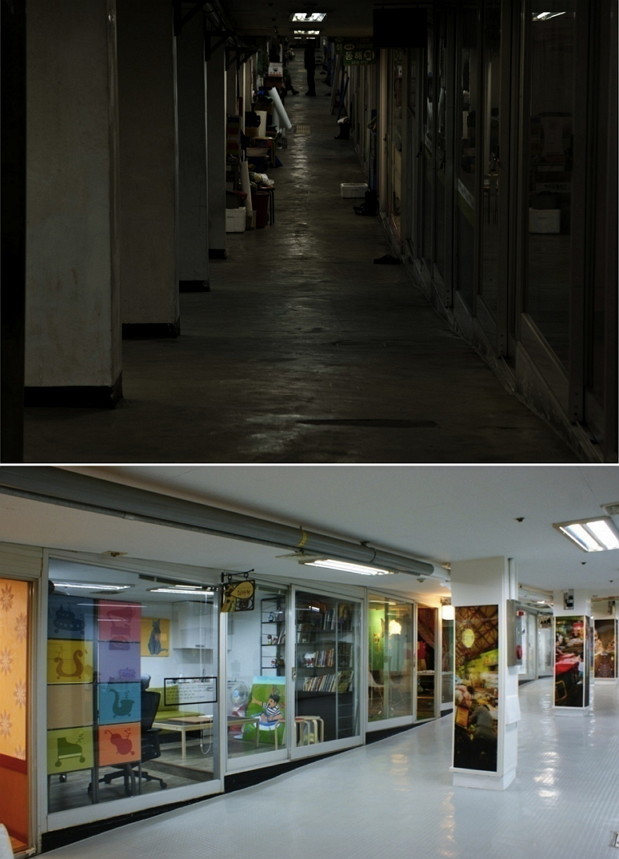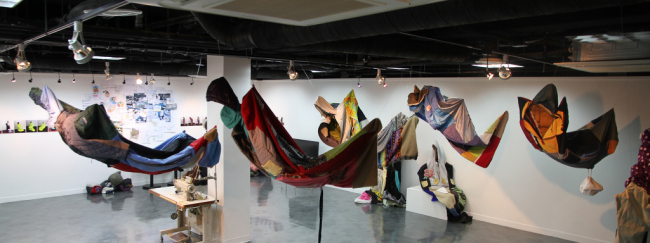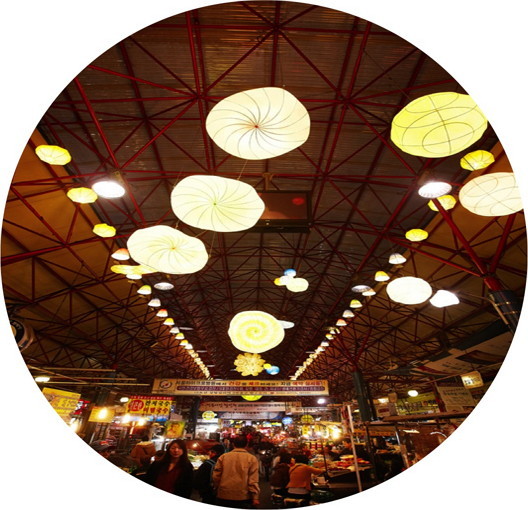Seoul’s ‘creative spaces’ integrate arts into urban landscape
By Korea HeraldPublished : July 16, 2014 - 20:50
A decade ago, the underground section of the Jungang Traditional Market in Sindang-dong, Seoul, was a place without a future. As merchants left the area one by one, what was once the site of flourishing small businesses had turned into a dungeon few cared to visit.
The fortune of this unfrequented area of Seoul was reversed in October 2007 when the Sindang Creative Arcade opened. The arcade is one of nine “creative spaces” currently under the auspices of the Seoul Foundation for Arts and Culture, an organization founded by the Seoul Metropolitan Government to support creative and artistic activities for the benefit of Seoul citizens.
The fortune of this unfrequented area of Seoul was reversed in October 2007 when the Sindang Creative Arcade opened. The arcade is one of nine “creative spaces” currently under the auspices of the Seoul Foundation for Arts and Culture, an organization founded by the Seoul Metropolitan Government to support creative and artistic activities for the benefit of Seoul citizens.

“Creative spaces” represent Seoul’s latest efforts to enhance the quality of urban living by integrating arts into the fabric of everyday life. Each “creative space” was previously unused real estate, subsequently transformed into a meeting place for artists and Seoul citizens.
The abandoned cubicles in the underground section were reborn as workspaces for artists and designers in what is now the Sindang Creative Arcade, and similar stories of urban regeneration can be recounted for each “creative space,” previously an unused factory, government building or public center.
While sharing this common vision, each “creative space” thrives in its distinctiveness. Sindang Creative Arcade, for example, is home to artists specializing in craftwork, such as “book artist,” Ahn Kyung-hee, who occupies one of 41 workstations in the arcade.
“Artists are foremost in need of a space where they can engage in artistic endeavors,” explained Ahn. While inspired to be engaged in collaborative work with fellow artists working around her, Ahn stated her interest in concentrating on “book art,” which treats books as artistic creations in themselves.
Admission into a “creative space” as a resident artist is by application, and successful applicants have access to the facilities ― writer’s rooms at Yeonhui Writers’ Village, dance studios at Hongeun Art Creativity Center and workspaces at Mullae Art Factory, to name a few ― for a minimal fee but under certain obligations, such as helping set up programs for the public.
While the notion of transforming unused spaces to be used by artists is easy to follow, how to connect the dots between “creative spaces” and the public so that art can play a larger role in the lives of the average citizen who may not have an interest in becoming a professional artist is less clear. This uncertainty stems in part from the independence of each location, but the problem is registered at a policy level as well.
A final report drafted for a policy seminar sponsored by the Seoul foundation in 2013, which is available on the foundation’s website, identified “the lack of clarity about who are the intended beneficiaries” ― the citizens versus the artists ― as one of the problems facing “cultural spaces.”
There is perhaps no single solution to this problem, and Seoul’s “creative spaces” have devised various ways to engage with citizens, capitalizing on the spaces’ individual strengths.
The Seongbuk Art Creativity Center, another “creative space” funded by the Seoul foundation at the Seongbuk District’s former public health center, for example, has made art therapy central to its identity. The only one of its kind in Korea, the center has invited professional art and music therapists to conduct programs for children, housewives, pregnant women and firefighters this season.
In addition, the center’s resident artists have incorporated the theme of “healing” into their projects. Last year, Ann Hyun-suk, a specialist in community art, spearheaded a campaign ― the Folding Zip House project ― to transform clothes donated by citizens into sleeping bags for the homeless with the center’s backing.

Stressing that “art is something that we share and not own,” Ann described the ameliorative effects of her project, which invited residents of homeless shelters to participate in the making of sleeping bags for those on the street.
Her work, Ann explained, promotes healing at multiple levels, from the healing of spaces associated with social malaise, to the healing of citizens who by donating clothes to her project feel connected to society at large, as well as the healing of the homeless who “come to realize that they are not neglected.”
Ann’s project and many others like hers push the boundaries of what constitutes as “creative spaces.” Though headquartered in an office provided by the Seongbuk Art Creativity Center, her project shows that “creative spaces” are not confined to the building itself, but may extend beyond its premises as art links formerly unconnected spaces through human relationships.
The Sindang Creative Arcade, in contrast, has approached the problem of making creative spaces the focal point of civic life differently. There the puzzle has been to make the “creative space” relevant to the immediate vicinity ― Jungang Traditional Market.
According to the supervising manager of the arcade, Kim Jin-ho, the relationship between the arcade and the merchants in Jungang market was initially frosty, as the latter feared that events put on by the arcade would disrupt their business.

Trust, explained Kim, gradually developed as he and his team took steps to bring together artists and merchants so that they could identify ways in which each side could further the other’s goals. Kim cited last year’s Hwanghakdong Byulgok, an annual autumn festival, organized in close collaboration with the merchants and a beautification project under the artistic direction of the arcade’s resident artists as having helped bring the two sides to a better understanding of their interlocking fates.
Prioritizing the arcade’s relationship with local merchants has meant making difficult choices for the management team at Sindang Creative Arcade.
“Originally, our goal was to popularize the arcade as much as possible,” explained Kim. “We later recognized that attracting too much attention could harm Joongang’s merchants because it would lead to the commercialization of the area, which would drive out small businesses. We have had to adjust our goals accordingly.”
The struggle to make “creative spaces” viable continues, even as previously unused spaces, like the underground section of the Jungang market or the former public health center in Seongbuk District, are given a new lease on life. Satisfying the needs of the public and meeting the demands of artists form two parts of an equation which holds the key to Seoul’s “creative spaces.”
“When you take into account the limited resources that we have to had work with,” said Sun Girl, a member of the management team at Seongbuk Art Creativity Center, “the fact that we have been able to host increasing numbers of projects each year since the center’s inception to great success shows how a little for the arts can go a long way.”
For more information on how to get involved in “creative spaces,” visit the website of the Seoul Foundation for Arts and Culture (www.sfac.or.kr).
By Moon Young-hoon (ymoon@heraldcorp.com)
-
Articles by Korea Herald



















